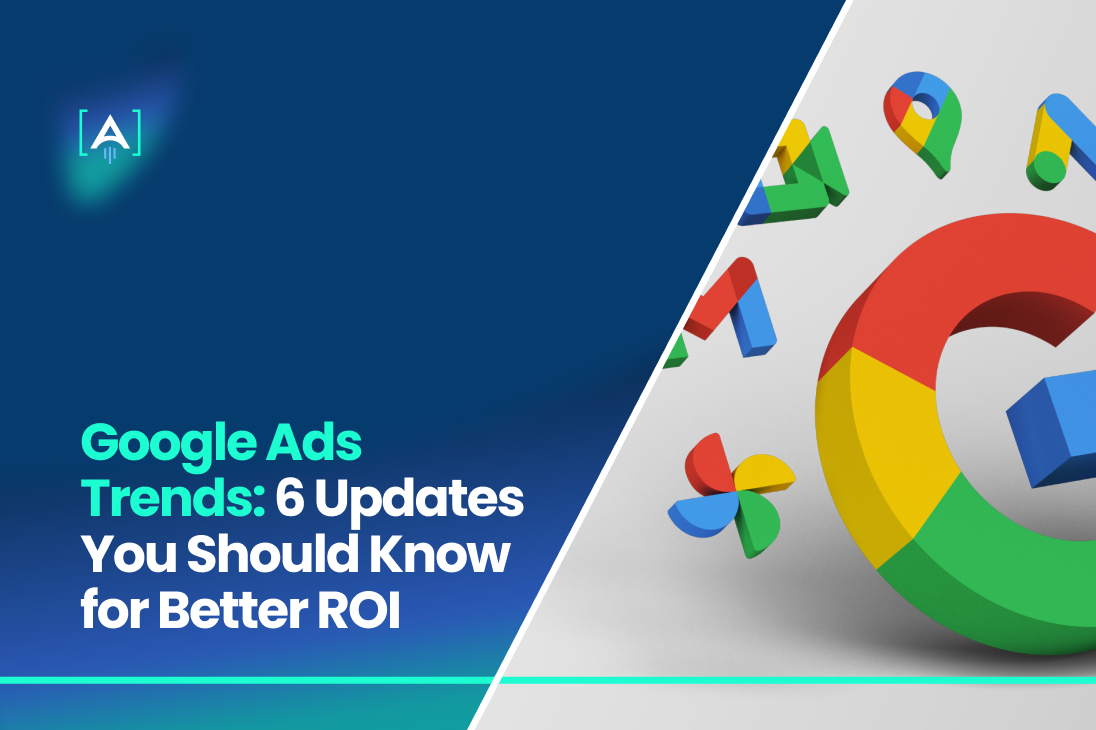Do you feel like your Google Ads budget isn’t stretching as far as it used to? You’re not alone.
With Google rolling out constant updates, what worked last year—or even last month—might not be as effective today.
But here’s the good news: staying on top of the latest Google Ads trends can give your business the edge to outshine the competition and maximize every dollar spent.
In this post, we’re diving into six game-changing trends in Google Ads that transform how businesses like yours reach customers.
Whether it’s tapping into AI-powered automation or mastering new bidding strategies, these updates can take your campaigns from “okay” to outstanding.
1. AI-Powered Features: Automation for Smarter Campaigns.
Source: Google
What if you could hand over the heavy lifting of your Google Ads campaigns to AI, allowing it to optimize your ads in real time?
That’s not a future vision—it’s happening right now.
AI is revolutionizing how Google Ads operates, and businesses that adopt these AI-powered features are already seeing better performance and reduced manual effort.
AI-Driven Search Campaigns: Smarter Targeting, Less Guesswork
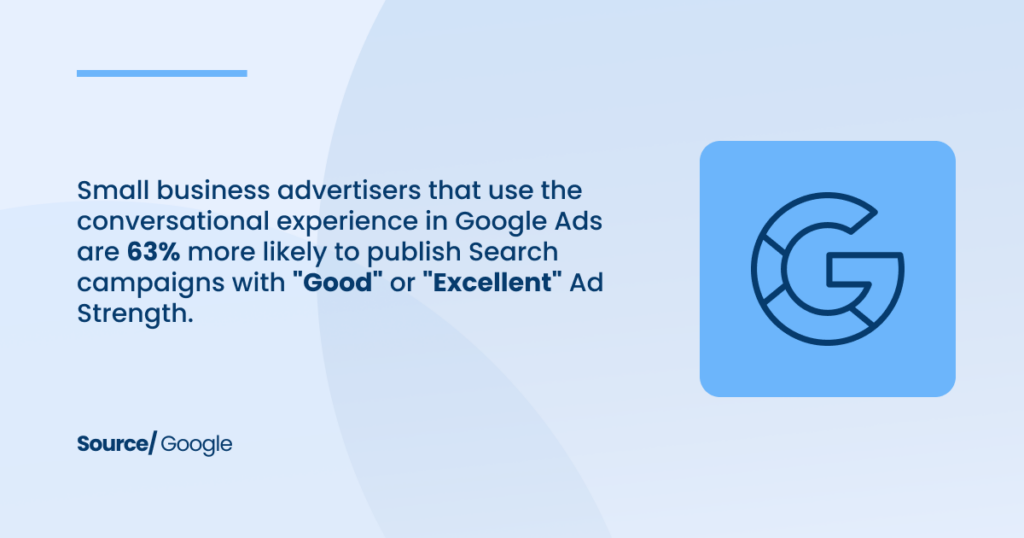
Source: Google
AI is becoming a game-changer in Google ads optimization.
With AI-driven search campaigns, Google automatically optimizes ad placements, bidding, and even keyword selection based on real-time data.
This means your ads are shown to the right people at the right time without you having to adjust settings constantly.
Imagine you manage a dental clinic in Chicago.
Your goal is to attract new patients—ranging from individuals searching for “emergency dental services near me” to families looking for “best pediatric dentist in Chicago” or even professionals searching for “teeth whitening clinics downtown.”
Each query represents a potential patient, but the keywords and timing can vary greatly.
With AI-driven search campaigns, Google Ads optimization automatically adjusts bids based on factors like the time of day, device, and user behavior.
This means your ads can reach a busy parent searching for “child’s first dentist visit” during a work break or a young professional researching “best cosmetic dentists” late at night.
Taking this further, instead of manually crafting different ads for every search, AI-powered responsive search ads let you enter several headlines and descriptions.
Google Ads then uses AI to test and learn which combinations resonate best with different users.
By partnering with a Google Ads agency, you can ensure these AI-powered features are integrated into your broader marketing strategy, maximizing every opportunity to connect with potential patients.
For instance, someone searching for “affordable dental services” might respond to an ad highlighting your clinic’s payment plans.
At the same time, a query for “cosmetic dentistry” could trigger an ad focused on your specialized whitening treatments.
Generative AI for Enhanced Creativity
Google’s Performance Max, powered by AI, optimizes your budget dynamically across all channels, driving 19% higher ROAS than other automated campaigns.
It also enables AI-generated creatives to tailor ads to your audience.
How to Leverage It:
- Use Performance Max to automate budget allocation across search, display, YouTube, and more, ensuring your ads reach the right people at the right time.
- Input multiple headlines, descriptions, and images for responsive search ads and let AI test and optimize the best combinations.
- Incorporate Google AI’s generative tools to produce diverse ad creatives without needing an in-house design team, ensuring your ads stay fresh and engaging.
Demand Gen Campaigns for Discovering New Customers
Google’s new Demand Gen campaigns focus on visual-first storytelling on YouTube and other non-search channels, reaching users who aren’t actively searching but are open to discovering new products.
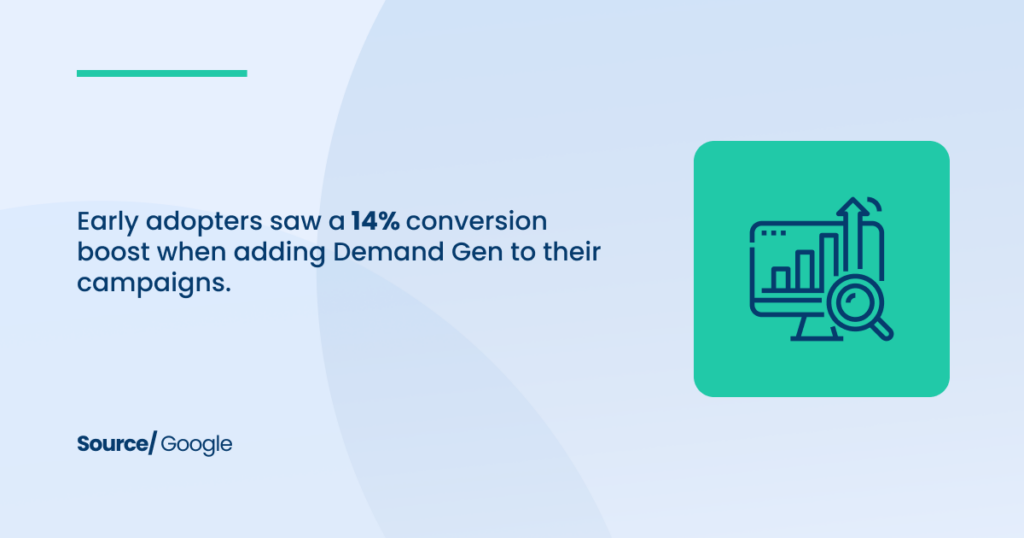
Source: Google
How to Leverage It:
- Combine Demand Gen with Search and Performance Max campaigns to target users in the consideration phase, using immersive video content to generate interest.
- Pin high-quality video assets to specific formats in your Demand Gen campaigns, ensuring your most engaging content appears in the right places.
- Customize messaging and visuals for specific audiences, ensuring each group gets the most relevant experience.
AI-Powered Image Editing for Campaigns
AI-driven image editing is now available for Search, Demand Gen, App, and Display campaigns, making it easier to edit and improve your images directly from Google Merchant Center.
How to Leverage It:
- Enhance your product visuals with AI-generated edits to improve ad quality and engagement, especially if you lack a dedicated design team.
- Use image enhancements to optimize visuals for different audiences and channels, ensuring your ads are visually compelling across all placements.
Brand Consistency with Performance Max
Full brand guidelines are available in Performance Max, which lets you define and upload specific brand elements—like fonts, colors, and logos—ensuring consistency across all ad formats.
How to Leverage It:
- Upload your brand assets into Google Ads to maintain a consistent visual identity across all campaigns and build stronger brand recognition.
- Use the brand guidelines feature to ensure every ad aligns with your brand identity, whether on Search, YouTube, or Display ads.
2. Smart Bidding & Automation: Let AI Handle the Heavy Lifting
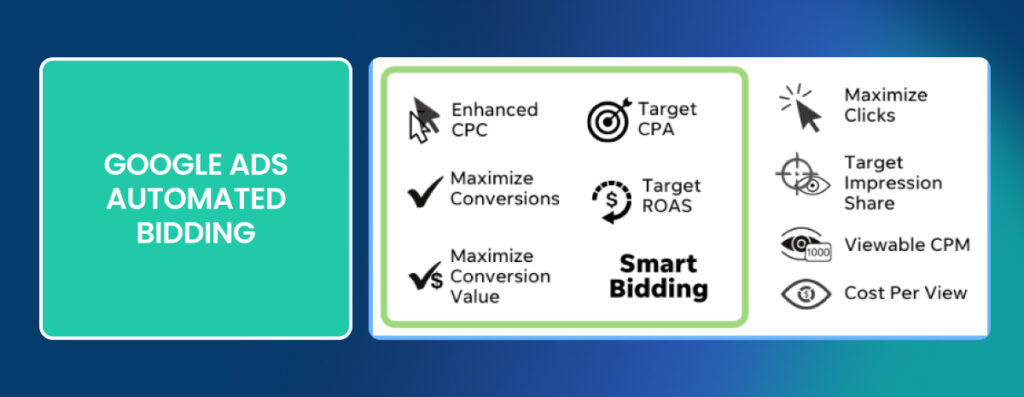
Managing bids manually can be exhausting and inefficient.
That’s where one of the relevant trends in Google ads, Smart Bidding, steps in.
Powered by Google’s AI, Smart Bidding automatically adjusts your bids in real time to help you hit your goals, whether boosting conversions or improving return on ad spend (ROAS).
Smart Bidding is a must if you want to get more value from your Google Ads.
Here’s what you need to know and how to use it:
How Smart Bidding Works
Google ads bidding strategies leverage machine learning to estimate the likelihood of a conversion and adjust bids accordingly.
It factors in multiple data points, like the user’s device, location, and time of day, giving you better results than manual bidding.
Key Smart Bidding Strategies
- Target CPA (Cost Per Acquisition): Adjusts bids to get conversions at your set CPA goal.
- Target ROAS (Return on Ad Spend): Maximizes the revenue you earn for every dollar spent.
- Maximize Conversions: Optimizes bids to get the highest number of conversions within your budget.
- Maximize Conversion Value: Focuses on getting the most revenue, not just conversions.
Why Smart Bidding Works
Smart Bidding adjusts bids in real-time using auction-time bidding. It analyzes key signals like:
- Device (mobile, desktop, tablet)
- Location and time of day
- User behavior and previous interactions
These signals allow AI to make smarter decisions, ensuring you only spend more when it’s worth.
How to Use Smart Bidding
Source: Google
- Align with Your Goals: Choose a strategy that fits your business goals. Use Target CPA to generate leads or Maximize Conversion Value if you’re focused on revenue.
- Leverage Reports: Track performance using bid strategy reports. These insights will help you fine-tune your campaigns.
- Test and Adjust: Run experiments with different Smart Bidding strategies to see what works best for you.
Pro Tip: Be Patient
Smart Bidding takes time to optimize fully.
To see real improvements, let your campaigns run for at least 30 conversions (or a month). The longer they run, the smarter they get.
3. The Rise of Broad Match Keywords: Maximizing Reach
Broad match keywords are making a big comeback, and for good reason.
Broad match, using Google AI, lets you reach a larger audience by displaying your ads for searches related to your keywords, even if the exact words aren’t used.
This is one of the most important Google Ads trends for businesses looking to expand their visibility.
What Makes Broad Match So Powerful?
Broad match uses AI to grasp the intent behind a search, unlike exact or phrase match, which focuses on specific keywords.
This means it can connect you with people searching for terms related to your business, even if they’re not using your exact keywords.
The best part? When paired with Smart Bidding, it only bids on searches likely to convert, ensuring you don’t waste your budget on irrelevant traffic.
How Broad Match Works in Your Favor
With broad matches, Google Ads casts a wider net.
For instance, if you own a fitness studio and target “gym memberships,” Broad Match could show your ad to people searching for “best workout classes,” “affordable fitness plans,” or even “yoga near me.”
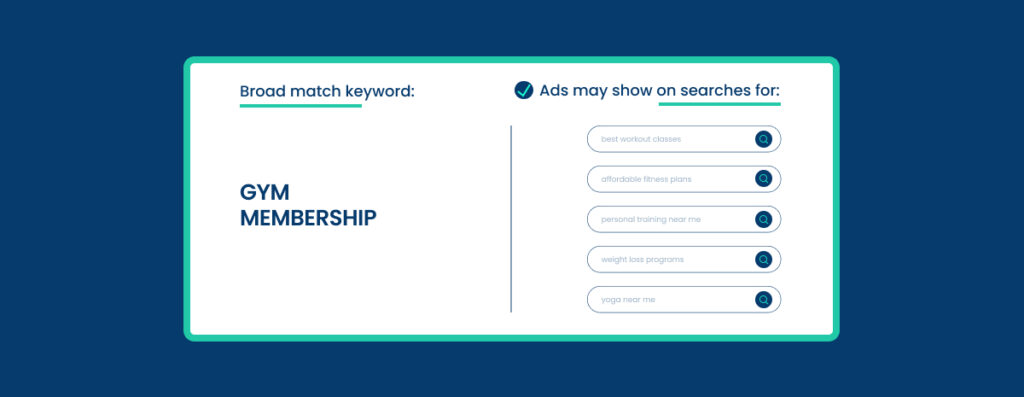
So you can reach more people who may not have searched for your exact keyword but are still interested in your services.
How to Use Broad Match Effectively
- Pair it with Smart Bidding: To make the most of a broad match, combine it with Smart Bidding strategies like Maximize Conversions or Target ROAS. This ensures you’re bidding on the most relevant searches.
- Use Negative Keywords: To avoid irrelevant traffic, add negative keywords to your campaign. This tells Google what terms you don’t want your ad showing up for, keeping your traffic high-quality.
- Expand Your Reach: By leveraging broad match, you can stay ahead of market shifts and evolving search trends, capturing traffic you might not have considered otherwise.
4. Interactive Ads: Enhancing Engagement Through Rich Media
Interactive ads are one of the most exciting Google Ads trends businesses should leverage.
These ads use rich media—like images, videos, and interactive elements—to create a more engaging experience that captures attention and drives user interaction.
Interactive ads go beyond static visuals by inviting users to engage with your content.
Whether they click on a carousel, watch a video, or interact with a product demo, these ads create a deeper connection with your audience.
This type of engagement boosts click-through rates (CTR) and leads to higher conversions as users feel more involved.
Types of Interactive Ads to Use
Source: Spott
- Video Ads: Use YouTube or in-stream ads to deliver engaging video content. Videos help tell a story, demonstrate your product, or highlight customer testimonials.
- Image Extensions: Add high-quality images to your search ads to grab attention and offer a visually appealing experience.
- Carousel Ads: Make users swipe through multiple images, showcasing different products or features, making it ideal for eCommerce businesses.
How to Leverage Interactive Ads
- Test Multiple Formats: Mix video, image, and carousel ads to see which engages your audience the most. For example, combine image extensions with traditional search ads for a more dynamic experience.
- Tell a Visual Story: Use videos to highlight customer success stories, product demonstrations, or tutorials. This encourages users to stay engaged longer, increasing the likelihood of conversions.
- Enhance Product Listings: For eCommerce businesses, carousel ads can show multiple product images, allowing users to interact with your ad by exploring different options.
Let’s say you run an online fashion store. With interactive ads, you could use a carousel to showcase seasonal collections.
You can also create a short video highlighting a new clothing line and include it as a YouTube ad.
These interactive elements give users a hands-on experience, encouraging them to explore your products further.
Interactive ads are more than just eye-catching—they actively engage your audience.
As one of the key Google Ads trends, using rich media in your campaigns can significantly boost engagement and conversions, making your ads more memorable and effective.
5. Voice-Activated Ads: Preparing for the Future of Search
The increasing use of devices like Alexa, Siri, and Google Assistant makes voice searches a regular part of how people find information.
As one of the latest Google Ads trends, businesses need to start optimizing their campaigns for this growing search method.
Voice-activated ads present a new way to reach customers, especially as more people use voice search to find local businesses, services, and products.
Rather than using brief phrases, people now ask complete, conversational questions such as, “Where’s the best coffee shop near me?” or “What’s the best marketing agency in town?”
This shift means businesses must tailor their ads and content to match more natural, spoken language queries.
How to Prepare for Voice Search Ads
- Focus on Long-Tail Keywords: Voice searches are longer and more conversational. Instead of focusing solely on short keywords, optimize your ads for long-tail phrases that reflect how people speak. For instance, instead of just targeting “coffee shop,” you could use phrases like “best coffee shop open now” or “affordable coffee shop near me.”
- Optimize for Local Search: Many voice searches are local, with users asking for nearby businesses or services. Ensure your Google Ads and landing pages are optimized for location-based keywords, and keep your Google My Business profile updated to boost your visibility in local voice search results.
- Create Conversational Content: Make your ad copy and landing pages more conversational. Answer common questions that customers might ask through voice search. This makes your content more relevant to voice-activated queries, increasing the chances that your ads will be shown.
Imagine you run a home repair service. Voice searchers might ask, “Who can fix my leaking sink today?” or “Emergency plumber near me.”
Adjusting your ads for conversational questions helps you appear in voice searches and attract ready-to-buy customers.
6. Google Analytics 4 (GA4): Enhanced Measurement & Attribution
As one of the key trends in Google Ads, GA4 offers advanced tracking, giving you a clearer view of how users interact with your business across different devices and platforms.
What’s New with GA4?
GA4 provides deeper insights into the entire customer journey.
Unlike the previous version, it can track users across devices and sessions, helping you understand how they engage with your ads over time.
Key Benefits of GA4
- Cross-Platform Tracking: GA4 tracks users across websites, mobile apps, and other platforms, offering a complete picture of the customer journey.
- Event-Based Data: GA4 focuses on events rather than just page views, letting you track specific actions like clicks, video plays, or purchases with more detail.
- Improved Attribution Models: GA4 helps you identify the touchpoints that lead to conversions, giving you better insight into which ads or campaigns drive results.
How to Leverage GA4 for Google Ads
- Track Key Events: Set up event tracking to monitor important actions, like purchases, form submissions, or video views, so you can see what’s working and where users drop off.
- Use Enhanced Attribution: Use GA4’s improved attribution models to see which ad touchpoints lead to conversions. This helps optimize future campaigns by focusing on what works best.
- Monitor Cross-Device Behavior: GA4 shows how users engage with your ads across devices so you can better understand their journey and refine your ads for higher impact.
For example, if you manage an online store, GA4 can monitor how users engage with your ads across different devices—starting with a click on their phone and then browsing on a desktop before completing a purchase.
This cross-device tracking gives you a comprehensive view of the customer journey, helping you adjust your strategy and optimize your Google Ads.
Key Takeaways
- AI-Powered Features: Google Ads’ AI tools like Performance Max and responsive search ads can help automate and optimize your campaigns across multiple channels, driving better results with less manual effort.
- Smart Bidding: Leverage Smart Bidding strategies like Target CPA and Maximize Conversions to automatically adjust bids based on real-time data, ensuring you reach high-value customers without the guesswork.
- Broad Match Keywords: Broaden your reach with AI-driven broad matches, which allow your ads to show for related search terms and expand your audience beyond exact keyword matches.
- Interactive Ads: Use rich media formats like video and carousel ads to engage users deeply, boosting click-through rates and conversions through interactive content.
- Voice-Activated Ads: Prepare for the rise of voice search by focusing on conversational, long-tail keywords and optimizing for local intent to capture high-intent leads.
- GA4 Tracking: Google Analytics 4 offers advanced tracking and attribution models, helping you understand the full customer journey.
Leverage These Google Ads Trends for Maximum ROI
To stay competitive and ensure your Google Ads campaigns deliver the best results, it’s crucial to adapt to the latest trends.
Whether it’s leveraging AI-powered features, automating your bids with Smart Bidding, or optimizing for voice search and GA4, these updates are shaping the future of digital advertising.
If you need expert guidance in navigating these changes, the Google Ads experts at Azarian Growth Agency can help.
Our team can optimize your campaigns, implement cutting-edge strategies, and ensure you get the most out of your ad spend. Ready to maximize your ROI?
